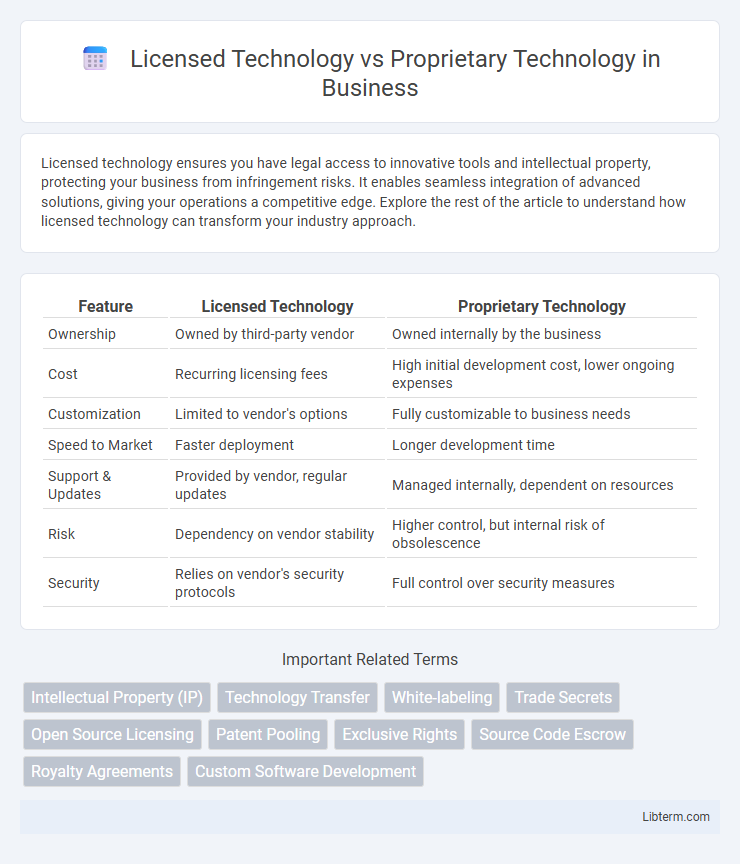Licensed technology ensures you have legal access to innovative tools and intellectual property, protecting your business from infringement risks. It enables seamless integration of advanced solutions, giving your operations a competitive edge. Explore the rest of the article to understand how licensed technology can transform your industry approach.
Table of Comparison
| Feature | Licensed Technology | Proprietary Technology |
|---|---|---|
| Ownership | Owned by third-party vendor | Owned internally by the business |
| Cost | Recurring licensing fees | High initial development cost, lower ongoing expenses |
| Customization | Limited to vendor's options | Fully customizable to business needs |
| Speed to Market | Faster deployment | Longer development time |
| Support & Updates | Provided by vendor, regular updates | Managed internally, dependent on resources |
| Risk | Dependency on vendor stability | Higher control, but internal risk of obsolescence |
| Security | Relies on vendor's security protocols | Full control over security measures |
Understanding Licensed Technology
Licensed technology grants businesses permission to use specific innovations or intellectual property under agreed terms without owning them, enabling access to advanced tools and expertise. This model supports cost efficiency by avoiding extensive R&D expenses and accelerates market entry through established technological solutions. Licensed technology often includes patents, software, and manufacturing processes protected legally to ensure proprietary rights while facilitating controlled usage.
What is Proprietary Technology?
Proprietary technology refers to systems, software, or hardware owned and controlled exclusively by a company or individual, often protected by patents, copyrights, or trade secrets. This technology restricts usage, modification, or distribution without explicit permission from the owner, ensuring competitive advantage and market control. Companies leverage proprietary technology to differentiate products, maintain exclusive rights, and maximize revenue through licensing or direct sales.
Key Differences: Licensed vs Proprietary Technology
Licensed technology grants users legal rights to use, modify, or distribute a product under specific terms set by the licensor, often involving fees or royalties. Proprietary technology is owned exclusively by a company or individual, with restrictions on access, use, and modification, ensuring competitive advantage and control over intellectual property. The key difference lies in ownership and usage rights: licensed technology offers conditional access, while proprietary technology maintains full ownership and tight control.
Advantages of Licensed Technology
Licensed technology offers significant cost savings by eliminating the need for extensive in-house research and development, allowing businesses to access proven innovations quickly. It provides easier scalability and faster market entry since companies can integrate mature technologies without starting from scratch. Access to licensed technology also includes ongoing support and updates from the original developers, ensuring reliability and reducing the risks associated with new technology deployment.
Benefits of Proprietary Technology
Proprietary technology provides companies with exclusive control over their intellectual property, enabling them to maintain competitive advantages and generate higher profit margins. It fosters innovation by allowing customized development tailored specifically to a company's strategic goals without reliance on external entities. Additionally, proprietary technology enhances brand differentiation and customer loyalty through unique features and performance not available in licensed alternatives.
Risks and Limitations of Licensed Technology
Licensed technology often involves restrictions on usage rights, leading to limited flexibility and potential dependency on the licensor's terms and updates. There is a risk of increased costs due to royalties or license fees, which can impact budget predictability and overall project viability. Compatibility issues and limited customization options further constrain innovation and adaptation to specific business needs.
Challenges Associated with Proprietary Technology
Proprietary technology often faces challenges such as limited compatibility with other systems, leading to integration difficulties and increased costs for customization. Dependence on a single vendor for updates, support, and innovation can restrict flexibility and slow down technological advancement. High licensing fees and restrictive usage terms further complicate adoption and scalability for businesses.
Cost Implications: Licensed vs Proprietary
Licensed technology often entails ongoing royalty payments or licensing fees, which can lead to higher long-term costs compared to proprietary technology. Proprietary technology typically requires significant upfront investment in development but offers greater control and potentially lower operational expenses over time. Businesses must evaluate the balance between initial costs and recurring fees to determine the most cost-effective approach for their specific needs.
Industry Examples of Both Technologies
Licensed technology often involves companies like Microsoft, which licenses its Windows operating system to various hardware manufacturers, allowing widespread adoption without relinquishing ownership. Proprietary technology is exemplified by Apple's iOS, used exclusively on Apple devices, ensuring tight control over the hardware-software ecosystem. The automotive industry showcases licensed technology through Tesla's sharing of certain patents for electric vehicle innovation, while traditional automakers maintain proprietary systems for in-house vehicle software and components.
Choosing the Right Technology Model for Your Business
Choosing between licensed technology and proprietary technology hinges on your business's need for control, cost efficiency, and innovation speed. Licensed technology offers established solutions with predictable costs and lower development risk, ideal for businesses seeking rapid deployment without extensive customization. Proprietary technology provides exclusive control and competitive advantage through tailored innovation, best suited for companies aiming to differentiate their offerings and retain full ownership of intellectual property.
Licensed Technology Infographic

 libterm.com
libterm.com